Gioia Tauro
Gioia Tauro is a comune (municipality) in the province of Reggio Calabria, in Calabria (Italy), on the Tyrrhenian coast. It has an important port, situated along the route connecting Suez to Gibraltar, one of the busiest maritime corridors in the world.[3]
Gioia Tauro | |
|---|---|
| Città di Gioia Tauro | |
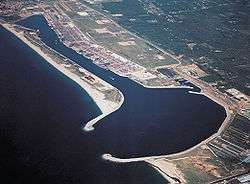 Seaport of Gioia Tauro | |
 Coat of arms | |
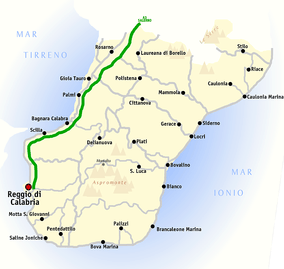 Map of the province of Reggio Calabria, with Gioia Tauro located to the north at the A2 motorway (A2 depicted in green). | |
Location of Gioia Tauro 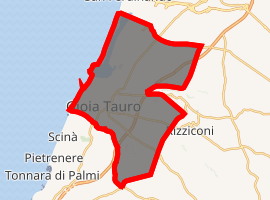
| |
 Gioia Tauro Location of Gioia Tauro in Italy 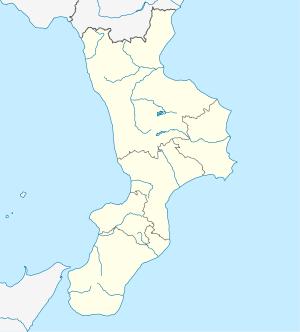 Gioia Tauro Gioia Tauro (Calabria) | |
| Coordinates: 38°26′N 15°54′E | |
| Country | Italy |
| Region | Calabria |
| Metropolitan city | Reggio Calabria (RC) |
| Government | |
| • Mayor | Aldo Alessio |
| Area | |
| • Total | 38 km2 (15 sq mi) |
| Population (November 2012)[2] | |
| • Total | 19,227 |
| • Density | 510/km2 (1,300/sq mi) |
| Demonym(s) | Gioiesi |
| Time zone | UTC+1 (CET) |
| • Summer (DST) | UTC+2 (CEST) |
| Postal code | 89013 |
| Dialing code | 0966 |
| Patron saint | St. Hyppolite |
| Saint day | August 13 |
| Website | Official website |
History
Gioia Tauro has been continuously inhabited for more than 2500 years. From about 400 BC or so it was inhabited by Greek colonists who called it Matauros or Metauros (Ancient Greek: Μέταυρος). Solinus write that it was established by Greeks from the Zancle.[4] It was one of the smaller ancient Greek centers among the settlements in Southern Italy (Magna Graecia). The ancient poet Stesichorus is said to have been born there. The remains are a little further inland in the old town of Gioia Tauro on a rise overlooking the Tyrrhenian Sea.[5]
In the 1970s, Gioia Tauro was the main centre for industrial development in Southern Italy, following a burst of violence in Reggio Calabria in 1970, signaling frustration over the central government's neglect of the region. The construction of a large steel plant and port facility was meant to bring income and jobs to Calabria. Until then Gioia Tauro had been a productive and beautiful agricultural area. Profitable farms and olive groves were expropriated and demolished.[3][6]
The 'Ndrangheta, a Mafia-type criminal organisation based in Calabria, and in particular the Piromalli clan, exploited the construction of the steelworks until the project was abandoned in 1979, when the crisis in the steel industry could no longer be ignored and the government decided there was no economic basis for it. In the meantime some 1,000 people were killed in conflicts over construction contracts. For a while the homicide rate of Gioia Tauro, was higher than that of New York City.[7]
Following this, a proposed electrical energy power station was never built, due to environmental problems. Gioia Tauro became an example of the failure that characterized much of the development of Italy's South as "industrialisation without development."[3][6]
Gioia Tauro seaport
The seaport has seven loading docks with an extension of 4,646 metres (15,243 ft); it is the largest in Italy and the seventh-largest container port in Europe,[8] with a 2007 throughput of 3.7 million TEUs[9] from more than 3,000 ships. In 2018 the port was in eighth place for EU container traffic, on a higher throughput of 4.05 million TEU [10]
In 2002 more than one-third of national traffic went through the seaport; it specializes in transshipment activities, replacing the port of Malta as the node for overseas traffic to and from the US and the Far East. The Medcenter Container Terminal (Medcenter, Contship) is the main operator working in the port.
'Ndrangheta control of port
According to a 2006 report, Italian investigators estimate that 80% of Europe's cocaine arrives from Colombia via Gioia Tauro's docks. The port is also involved in the illegal arms trade. These activities are controlled by the 'Ndrangheta.[11] In 2014 the US FBI and the Italian police made arrests in a joint operation aimed at smashing a new trafficking route for drugs and weapons that officials said had brought together the Gambino crime family of New York and the 'Ndrangheta. It was alleged that representatives of the criminal organisations discussed plans to ship cocaine and heroin from Gioia Tauro to the United States, selling more than 1.3 kilograms (2.9 lb) of heroin to an FBI undercover agent, thinking it would be distributed across the United States. A mafia expert said that the US mafia understood that the Sicilian Cosa Nostra had been so weakened that it allowed the 'Ndrangheta to rise.[12]
“In the 1970s, the Christian Democratic Italian Government (with the active encouragement of the left) appropriated (and wasted) tens of billions of dollars to build one of the country’s largest steel plants in Calabria, but the project was abandoned because of a crisis in the steel industry.... “The government ultimately completed construction of a huge seaport at Gioia Tauro (the sixth largest in the Mediterranean) which was originally meant to service the steel plant....[Alex] Perry [in his book, “The Good Mothers: The True Story of the Women Who Took on the World’s Most Powerful Mafia,” William Morrow publishers, 2018] notes that ‘the railway that connected Gioia Tauro to Europe stopped 1.5 kilometers short of the port, meaning all the cargo’ — legal and illegal — ‘from one of the biggest Mediterranean container ports had to be loaded onto mafia-owned trucks and driven three minutes to the station.’ The port’s legitimate business has struggled in recent years, no doubt a result of Mafia control.” “Breaking the Silence in Calabria,” Alexander Stille, The New York Review of Books, Vol. LXVI, No. 16 (October 24, 2019)
The Piromalli-Molè clan managed to condition the management of the new container terminal. Established in the mid-1990s, it became the largest terminal in the Mediterranean, moving over 2 million containers in 1998. Since 1994, when Contship Italia rented the port area to start transshipment activity and the Medcenter Container Terminal was set up thanks to 138 billion lire (about US$86 million) in state financing, the Piromallis aimed to oblige the Medcenter company, through its vice president Walter Lugli, and the Contship company, through its president Enrico Ravano, to pay a kickback of US$1.50 for each transshipped container, about half of the net profits earned by the two companies.[13][14]
In February 2008 the parliamentary Antimafia Commission concluded that the 'Ndrangheta "controls or influences a large part of the economic activity around the port and uses the facility as a base for illegal trafficking." In its report it said that "the entire gamma of internal or sub-contracted activities is mafia-influenced, from the management of distribution and forwarding to customs control and container storage." The extortion of Ravano and Contship was part of a project that "did not involve simply this security tax, which grew with the port, but also control of activities tied to the port, the hiring of workers, and relations with port unions and local institutions". "It effectively eliminated legitimate competition from companies not influenced or controlled by the mafia in providing goods and services, performing construction work and hiring personnel. And it threw a shadow over the behaviour of local government and other public bodies."[15][16]
'Ndrangheta infiltration of city council
The city council of Gioia Tauro was dissolved in 1991 because of infiltration by the 'Ndrangheta. In April 2008, it was dissolved for the second time for the same reason.[17] The town is home to several 'ndrine, such as the Alvaro, Mammoliti, Molè, and Piromalli families.
Gioia Tauro's former mayor and deputy mayor, Giorgio Dal Torrione and Rosario Schiavone, were arrested on mafia charges on October 13, 2008. Both had been forced to step down in April, when the city council was dissolved on suspicion of mafia infiltration. 'Ndrangheta boss Gioacchino Piromalli was arrested as well, along with his nephew, also named Gioacchino Piromalli, who is a lawyer. The mayors were accused of employing the younger Piromalli. Police believe the legal work was a front to enable the Piromallis to regain a slice of the business generated by the port of Gioia Tauro.[18]
Notable people
- Stesichorus – ancient poet
- Nick Nostro – film director
Winds
Demographic evolution
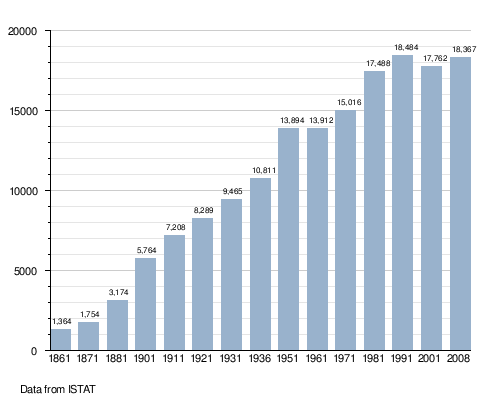
References
- "Superficie di Comuni Province e Regioni italiane al 9 ottobre 2011". Istat. Retrieved 16 March 2019.
- All demographics and other statistics from the Italian statistical institute (Istat)
- Success for Gioia Tauro, undated ADN Kronos report on Italtrade
- Solinus, Polyhistor, 2.10
- VisitsItaly.com - Welcome to Gioia Tauro, Calabria Archived 2012-09-07 at the Wayback Machine
- Spotts & Wieser, Italy, a Difficult Democracy, p. 236
- Spotts & Wieser, Italy, a Difficult Democracy, p. 186
- "World Port Rankings 2005". American Association of Port Authorities. May 2007. Archived from the original on 2007-09-27. Retrieved 2008-02-06.
- Van Marle, Gavin (2008-01-31). "Europe Terminals stretched to limit". Lloyds List Daily Commercial News. pp. 8–9.
- "Eurostat Top 20 EU Containger Ports". Eurostat.
- Bitter harvest, The Guardian, December 19, 2006
- Guardian newspaper:Police break transatlantic network of US and Italian crime families, 1 February 2014
- Paoli, Mafia Brotherhoods, p. 218
- (in Italian) Il caso Gioia Tauro, Relazione sullo stato della lotta alla criminalità organizzata in Calabria, Commissione parlamentare d'inchiesta sul fenomeno della mafia e delle altre associazioni criminali similari, July 2000
- Gioia Tauro 'controlled by mafia for over a decade', Lloyd’s List, February 21, 2008
- (in Italian) Relazione annuale sulla 'ndrangheta, Commissione parlamentare di inchiesta sul fenomeno della criminalità organizzata mafiosa o similare (Relatore: Francesco Forgione), February 2008
- (in Italian) Sciolto Consiglio comunale di Gioia Tauro, Corriere della Sera, April 22, 2008
- Mayors, mobsters in 'Ndrangheta op, ANSA, October 13, 2008
- Paoli, Letizia (2003). Mafia Brotherhoods: Organized Crime, Italian Style, New York: Oxford University Press ISBN 0-19-515724-9 (Review by Klaus Von Lampe) (Review by Alexandra V. Orlova)
- Spotts, Frederic & Theodor Wieser (1986). Italy, a Difficult Democracy: A Survey of Italian Politics, Cambridge University Press, ISBN 0-521-31511-5

